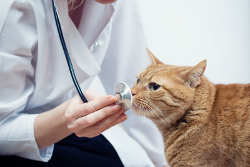If your cats are continuously licking any specific area of their skin, they are likely to be suffering from lick granuloma. This condition, also referred as lick dermatitis, can easily make your cat’s skin look scaly, patchy, irritated as well as flaky (leading to excessive dander). In this article we will touch on the various causes, symptoms, treatments as well as the prevention measures of this disorder.
Lick granuloma can be a viscous cycle for very many cats. Basically, by trying to scratch any uncomfortable area, your cat can repeatedly continue to lick and end up causing further irritation. If your cat happens to incessantly lick any area of the body ( usually the legs or feet) the area can become, sequentially: increasingly inflamed, red and itchy, infected, ulcerated and moist. Sometimes, the licking can become subconscious and habitual, causing your pet to lick after the area is no longer uncomfortable or itchy. So lets look at some of the various factors, which are likely to cause lick granulomas in your cat.
Causes of Lick Granulomas in Cats
Lick granulomas in cats are often caused by a combination of different factors. Generally, there is usually an initial reason for the cat licking the area, this can include:
- A small cut or similar injury
- Underlying allergies
- Insect bite or parasite infection
Usually, the causes can became complicated if not attended in time. This can cause the act of licking to be a compulsive behavioral habit. Once this happens, the lick granuloma complex can turn out to be a self perpetuating issue. For instance, the leg of the cat can become itchy, and hence making your cat lick compulsively. This can eventually make the cat’s leg become more itchy in the long run.
Due to the complex nature of the problem, the treatment may be needed for months or weeks to be successful and will usually involve trial and error of varying remedial treatment techniques. Note that not all cats often respond to the same treatment and thus patience as well as persistence may be needed in order to find the most effective treatment method. Let us have a look at the various treatment options you should use if you want to get rid of this condition.
Treatment Options For Lick Granulomas in Cats
Before you opt for any treatment option, it is always recommended that you first and foremost identify the underlying cause of the problem, if possible, and ensure that you treat it accordingly. Here are the various treatment options you should put into consideration if you want to get rid of this disorder. They include;
Chlorpheniramine (Chlor-Trimeton)
Chlorpheniramine (Chlor-Trimeton) can assist in relieving the itching. This product can be directly administered into the sore by injection. Note: as with all drugs, please consultant your vet to see if this is right for your pet.
Deter Scratching: Use an “Elizabethan Collars (aka E-collar)” or Bandage
This is usually considered by many as the best treatment option for this condition. If you opt for this treatment option, deter scratching by using a cone or e-collar and then use soothing creams and bandages to manage the discomfort, itch and inflammation.
E-collars come in various shapes and sizes and are made of different materials. The typical plastic E-Collar can be a little hard on your cats skin so for this reason we recommend a soft material con like the Comfy Cone Pet E-Collar.
Topical Skin Protectant
A topical skin protectant like Aardora can easily be used to lower the risk of infection of your cat, particularity if the skin is over irritated.
Extra Dose Of Tender Loving Care
Treating the cat with an effective extra dose of tender loving care i.e. TLC will always assist him /her to heal comfortably.
The Use Of Games and Toys
It’s so obvious that most people believe that this option cannot work when it comes to getting rid of this disorder. However, the truth of the matter is that this treatment alternative can work wonders if used appropriately. the use of games and toys can help in reducing any stress or boredom that your cat may be facing.
If you opt for this treatment option, surround the cat with its favorite pillows, toys, etc.
Use an “Elizabethan Collars (aka E-collar)” or Bandage
This can be another ideal alternative you can use to get rid of lick granuloma. Generally, you can physically prevent the act of licking in your cat by using Elizabeth collars, bandages, or even using the sedatives.
However, this treatment option may give your cat hard time each time he or she wants to lick but in the long run can easily work wonders.
Applying Antibiotics
Topically or oral applied antibiotics can be used to combat any infection present, which may be the likely cause of this disorder in your cat. You can visit any qualified veterinary to find details about some of the available antibiotics that is safe for you can use on your pet.
Surgery
Freezing (cyotherapy) or surgery is another alternative option you can opt for if you are not comfortable with the other treatment options. Surgery is ideal since the affected skin of your cat will be removed hence combating the problem permanently. This will suppress the itchy sensation and therefore completely reduce the cat’s urge to lick. However as with all surgery there are risks, so please discuss all factors with you vet.
Prevention Tips for Lick Granuloma
The best prevention for this condition is to address the source of the issue before it comes a bigger problem. If you discover that your pet is suffering from this disorder, you first course of action is to use a soothing topical creams like Zymox Topical Pet Cream with Hydrocortisone, 1-Ounce
The cream will help in managing the inflammation, discomfort as well as the itching your cat may be undergoing. Last but not the least; before you opt for any of the aforementioned treatment option for lick granuloma, ensure that you seek medical advice first and discuss your option with your vet.
Thanks for visiting www.catdandruffclinic.com, if you liked this article please like us using the side bar .



Comments are closed.